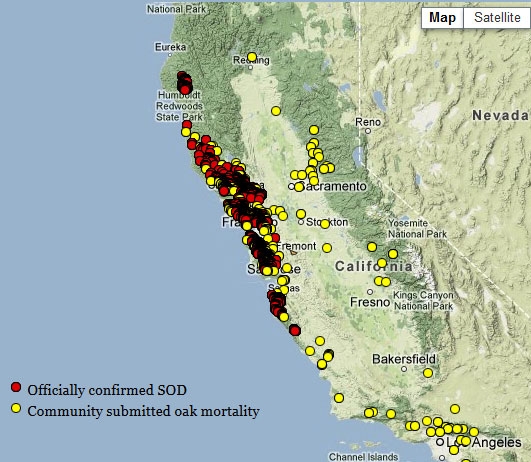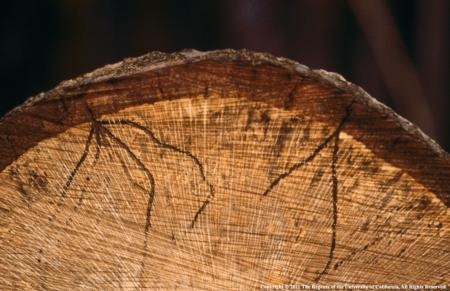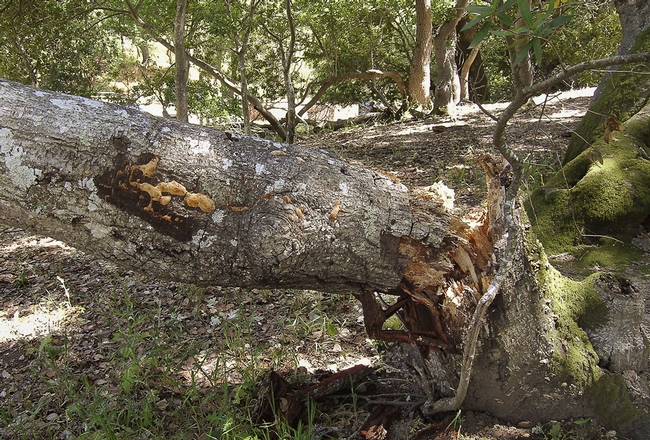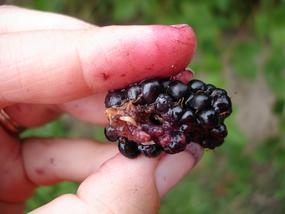Posts Tagged: SOD
Drought is slowing the spread of sudden oak death
Finally, some good news about the drought. Dry conditions have apparently curbed the spread of sudden oak death in 12 coastal California counties, reported Guy Kovner in the Santa Rosa Press Democrat.
"If we had one more year of drought, it would really be ideal," said Matteo Garbelotto, UC Cooperative Extension specialist in the Department of Environmental Science, Policy and Management at UC Berkeley.
The article said Garbelotto isn't hoping for more drought, but evidence shows that the drought is helping reduce SOD infection rates and in some cases is curing infected trees, "because the pathogen dies."
Each spring, the UC Berkeley SOD lab hosts a "blitz" to gauge the spread of Sudden Oak Death. Volunteers fan out across areas susceptible to SOD and collect leaf samples for analysis.
In the Cloverdale area, where an outbreak was confirmed last year, none of the trees sampled had the disease this year, the article reported.
"I would say it is there, but we just didn't find it," Garbelotto said.
East of Highway 101, the rate dropped from 26 percent infected last year to 23.3 percent in 2014, the story said.
Complete SOD blitz results will be available Sept. 29 on the UC Berkeley Forest Pathology and Mycology Lab website.
Citizen scientists being mobilized in Sonoma County
A Sudden Oak Death "Blitz" planned for Sonoma County June 15-16 will prepare local residents to spot infected plants, collect samples from their neighborhoods and submit them for laboratory testing, reported the Kenwood Press.
The session is hosted by UC Cooperative Extension Master Gardeners and Matteo Garbelotto, UCCE specialist in the Department of Environmental Science, Policy and Management at UC Berkeley.
Trees susceptible to sudden oak death include California bay laurel, tan oak, live oak, black oak, canyon live oak and shreve oak. After the laboratory analysis is complete, Garbeletto will schedule a return visit to discuss the findings of the survey and provide guidelines for action.
"If the disease front is 100 yards away, then one needs to decide whether some of his oaks should be protected," Garbeletto said. "For oaks up to 30 inches in diameter, removal of small and medium size laurels for a 10-yard radius around the oak trunk plus the application of AgriFos on the bark each year or every other year will protect the oak."
The information collected by the citizen scientists will also be added to Garbelotto's OakMapper website, a portal where SOD appearance in California is monitored.

An image from the Oak Mapper website (oakmapper.org) where citizen-submitted scientific data is collected.
Citizen scientists map Sudden Oak Death
Citizen scientists are once again beginning their annual Northern California search for signs of Sudden Oak Death, reported Lisa Krieger in the San Jose Mercury-News. Volunteers were trained in Santa Cruz on Friday and training sessions are planned for Orinda, Berkeley, San Francisco, Saratoga, Burlingame, Woodside, Atherton and Los Altos Hills.
"This outreach is really important because it not only teaches people how to look for the disease, but it also helps them to monitor for it in their community, allowing them to identify new outbreaks quickly," said Matteo Garbelotto, UC Cooperative Extension specialist in the Department of Environmental Science, Policy and Management at UC Berkeley.
Sudden Oak Death is caused by Phytophthora ramorum, a microbe that came to California from overseas. The disease has killed more than a million trees in 14 coastal counties from Monterey to Humboldt.

In this cross-section of a coast live oak killed by sudden oak death, the black-stained tunnels of adult ambrosia beetles can be seen extending into the wood.
Pests present border threat
"Whether they know it or not, every person in the country is affected by this, whether by the quality or cost of their food, the pesticide residue on food or not being able to enjoy the outdoors because beetles are killing off the trees," said Mark Hoddle, an entomologist specializing in invasive species at the University of California, Riverside.
Springs rains blamed for sudden oak death increase
Guy Kovner, The (Santa Rosa) Press Democrat
The level of sudden oak death infection in Sonoma County and other parts of the Bay Area tripled over last year's rate, according to a survey conducted in June in nine counties from Humboldt to Monterey.
“It's a red flag,” said Matteo Garbelotto, head of UC Berkeley's forest pathology laboratory.
What sustainability means in agriculture
Amanda Radke, Tri-State Livestock News
Amada Radke reported on a panel discussion on agricultural sustainability, which took place at UC Davis in September. The panel included farmers, activists and the dean of the UC Davis College of Agriculture and Environmental Sciences Neal Van Alfen.
“There is so much debate and controversy among naturally-raised foods and conventionally-raised foods, and that's too bad, because one isn't always better than the other,” said Van Alfen. “If we don't make our system work, we are all in trouble. We have to figure out how to feed the world sustainably. Research is so important to help farmers reduce input costs and work to make organic foods more sustainable and efficient.”


